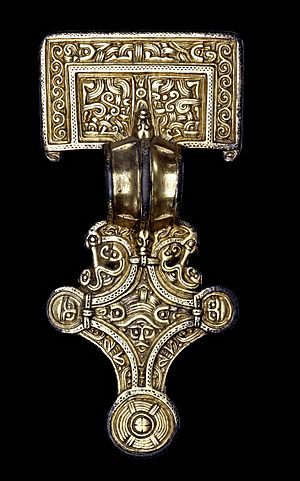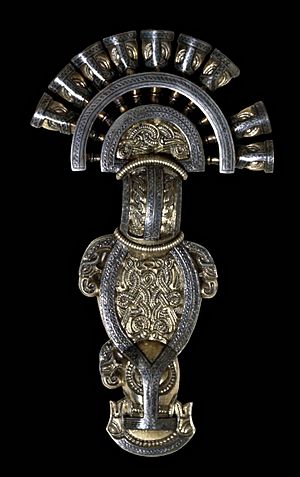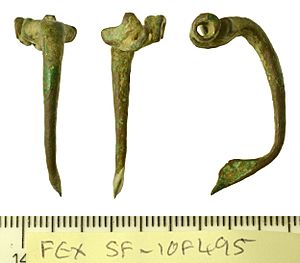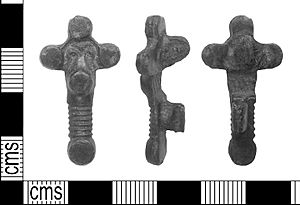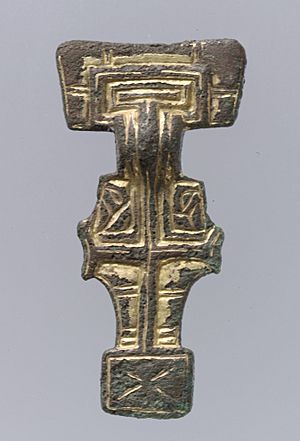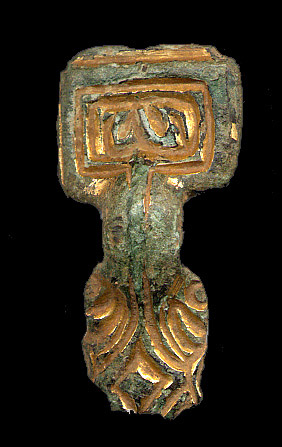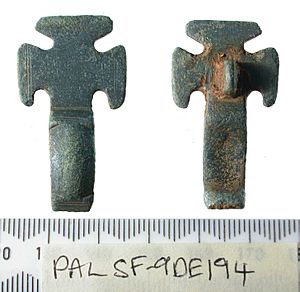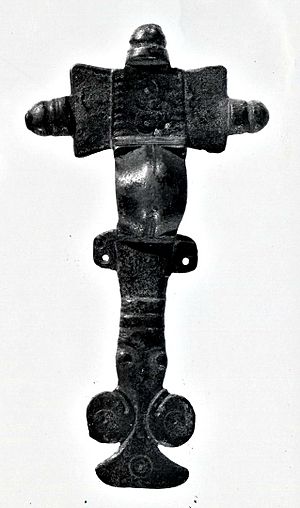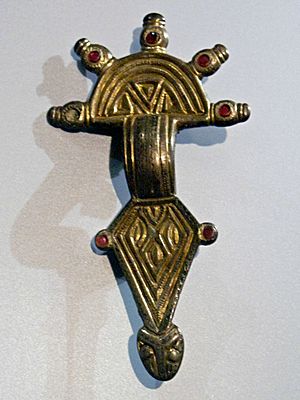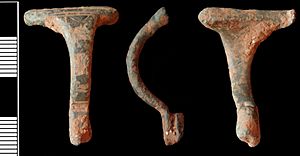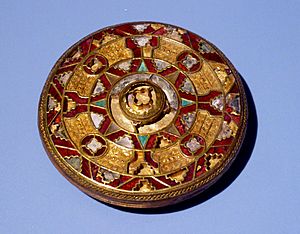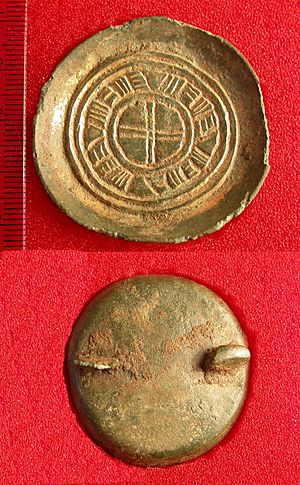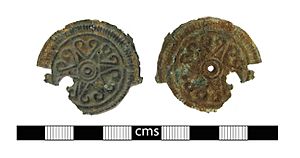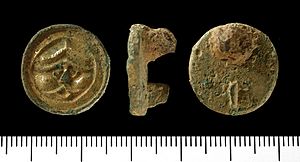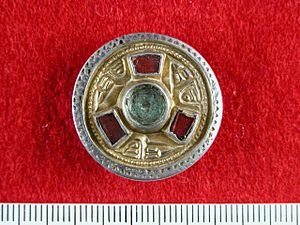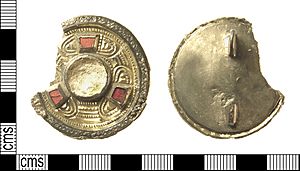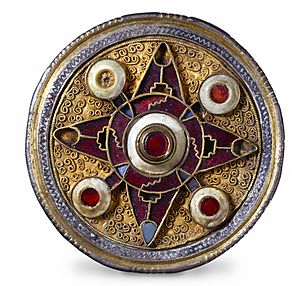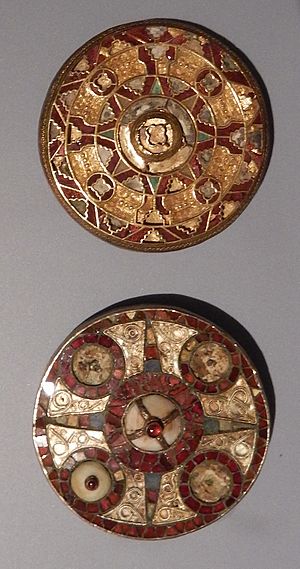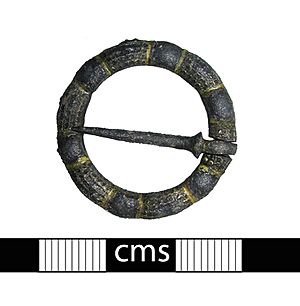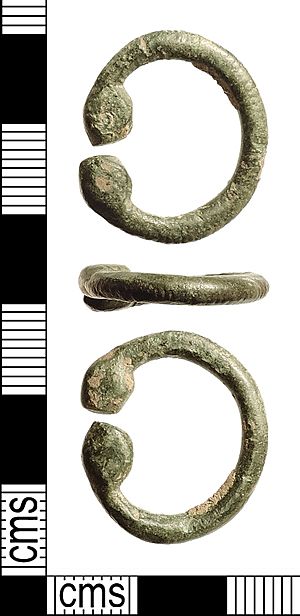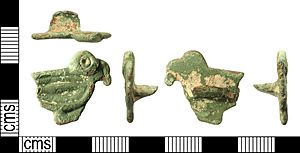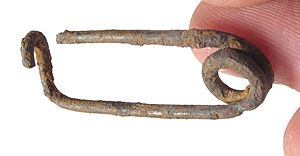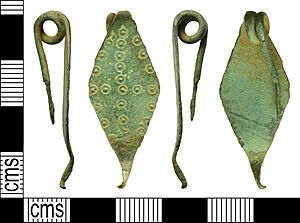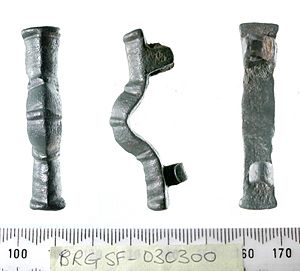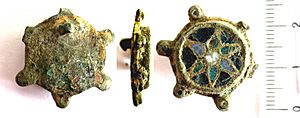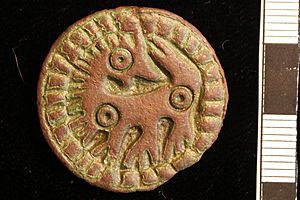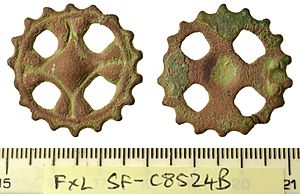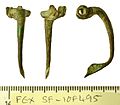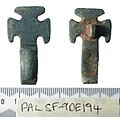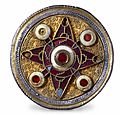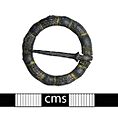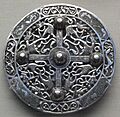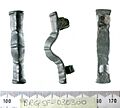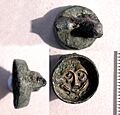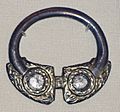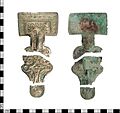Anglo-Saxon brooches facts for kids
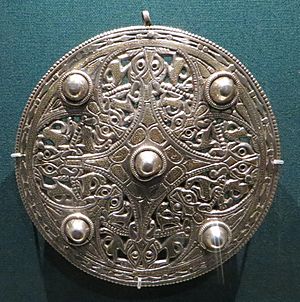
Anglo-Saxon brooches are beautiful decorative pins found in England. They were made and worn from the 400s to the 1000s. In the early Anglo-Saxon times, there were two main types of brooches. These were the long (or bow) brooch and the circular (or disc) brooch.
Long brooches included styles like cruciform, square-headed, and radiate-headed. These long brooches became less popular by the end of the 500s. Circular brooches became more common. They developed from fancy jewelled disc brooches made in Kent in the early 500s.
Some early circular brooches were called saucer, button, and annular (ring-shaped) brooches. The circular brooch was the most popular type during the middle and late Anglo-Saxon periods. Many of these were decorated with colourful enamel or had other designs.
A few other unique brooch styles existed too. These included bird-shaped and S-shaped brooches in the early Anglo-Saxon era. Later, safety-pin, strip, and rectangular brooches appeared.
Most early Anglo-Saxon brooches came from Europe. Over time, English metalworkers, especially in Kent, started making their own unique styles. Some of the most famous Anglo-Saxon brooches are the Sutton brooch, the Sarre brooch, the Fuller Brooch, the Strickland Brooch, and the Kingston Brooch.
Contents
What are Anglo-Saxon Brooches?
The Anglo-Saxon era in England began in the middle of the 400s. This period is divided into three parts. The early Anglo-Saxon era was from the mid-400s to the early 600s. The middle era covered the 600s to the 800s. The late era included the 900s and 1000s.
Anglo-Saxon brooches were decorative fasteners for clothes. Their main job was to hold pieces of clothing together. They usually had a pin, a clasp, and a spring hidden behind the front plate. The front plate could be plain, simply decorated, or very fancy. Brooches came in many sizes and shapes.
These ancient brooches are split into two main groups: long and circular. They were made from different metals like copper, iron, silver, or gold. Craftsmen used techniques like casting, inlaying, or engraving. Casting was popular because many brooches could be made from the same mould.
Most brooches in the Anglo-Saxon era were worn by women. A clothing historian named Penelope Walton-Rogers said that brooches were as important to Anglo-Saxon women as buttons and zippers are today. They helped hold clothes together and showed off a person's style. While women mostly wore brooches in the early period, they were less common as everyday accessories later on. Small, circular disc brooches were perfect for fastening cloaks. After the early 600s, plain disc brooches were sometimes worn by men.
When Were Brooches Popular?
Most brooches found from the early Anglo-Saxon period in England came from Europe and Scandinavia. The long brooch was a popular style in early Anglo-Saxon England. Circular brooches first appeared in England in the mid-400s.
By the 500s, skilled workers in Kent began making brooches in their own unique ways. The Kentish square-headed brooch and the circular jewelled brooches started in Kent. By the end of the 500s, circular brooches were the most popular type.
During the 600s, brooches became less common in England. But they came back into fashion in the 700s and stayed popular until the end of the Anglo-Saxon era. Circular brooches were the main style in the middle and late periods. Popular styles included the annular (ring-shaped) and jewelled disc brooches. These circular brooches were either enamelled (with colourful glass) or not.
A few non-circular styles were also worn from the 700s to the 1000s. These included ansate, safety-pin, and strip brooches. Ansate brooches were traditional European styles that became popular in England later on. Safety-pin brooches were more common early on. By the 700s, they changed into strip brooches. Other brooches from this time included bird, Ottonian, rectangle, and cross designs.
Some of the most famous Anglo-Saxon brooches are the Sutton brooch, the Sarre brooch, the Fuller Brooch, the Strickland Brooch, the Kingston Brooch, and the silver brooches from the Pentney Hoard.
Early Anglo-Saxon Brooches
Long Brooches
Long brooches, also known as bow brooches, came from older Roman bow-shaped pins. They include different kinds of square-headed, small-long, cruciform, and radiate-headed brooches. Long brooches have a head, a foot, and a curved middle part called the bow. The bow connects the head to the foot.
Roman brooches had a much larger bow than Anglo-Saxon ones. By the 400s, the bow on brooches was just a small bump in the middle.
Square-headed Brooches
Square-headed brooches usually have rectangular heads, even though their name says "square." The foot is often shaped like a diamond. Some types are cross-shaped, with animal designs where the bow and foot meet. These brooches started in Scandinavia in the 400s. They then spread to England and southern Europe by the late 400s.
In England, there are different kinds of square-headed brooches. These include the great square-head, the small square-head, and the Kentish square-head. They are often found in graves in Kent and East Anglia.
Great Square-headed Brooches
Great square-headed brooches are quite large, usually 10 to 15 centimetres long. They are also heavy. These were the most common brooches found in the graves of important women in the 400s and 500s.
They were usually made of copper alloy. Often, they were covered with gold, silver, or tin to make them shiny. These brooches were typically decorated with animal designs. Each great square-headed brooch seems to be unique. They were probably custom-made by travelling craftsmen.
Kentish Square-headed Brooches
There are two main styles of Kentish square-headed brooches. One is the Jutish-style, which looks like brooches from Jutland (in Denmark). These have lots of animal decorations and sometimes a disc on the bow. The other is the Continental-style. These have simpler animal designs and often include colourful garnet stones.
Both types were made of silver or silver-gilt. The Continental-style could also be gilded with copper alloy. These brooches were cast in small to medium sizes, from 4.5 to 10 centimetres long.
Small Square-headed Brooches
These are smaller versions of the great square-headed brooches. They were usually made from copper alloy, with a few made from silver. They were often gilded and could have raised decorations. They date from 500 to 575 AD.
These brooches are found across southern England, but mostly in eastern Kent. They were usually decorated with symbols and hidden marks. This is different from the animal designs on the larger square-headed brooches.
Small-long Brooches
The small-long brooch is similar to the cruciform and great square-headed brooches. These copper alloy brooches have the most design variations of all early Anglo-Saxon brooches. Their heads can be square, trefoil (three-lobed), or cross-shaped. Their feet can be triangular, lobed, crescent, or diamond-shaped.
Small-long brooches are mostly found in East Anglia, but also across England. They have simple designs, often with a small bronze bow. They are similar to cruciform brooches and might have been a cheaper version. They date from the late 400s to the 500s. They disappeared from Anglian sites earlier than other places in England.
Cruciform Brooches
Cruciform brooches are quite common in early Anglo-Saxon England. They might have started in Europe and Scandinavia in the late 300s. They are mostly found in eastern England, from Kent up to York. People wore them from the early 400s to the mid-500s.
Cruciform brooches have been found in Anglo-Saxon graves in different places. Sometimes two brooches were at the shoulders pointing up. Sometimes two were on the chest pointing down. Or just one on the chest pointing sideways.
You can spot a cruciform brooch by the three knobs or ends on its head. They were usually cast in copper alloy, with the knobs often made separately. Cruciform brooches could have simple or very detailed decorations.
Radiate-headed Brooches
Radiate-headed brooches were popular in Kent in the 500s. This was probably because many Frankish people moved to that area. This brooch style came from Francia (a region in Europe). Radiate-heads were usually made of copper alloy, with a few in silver.
Their special feature is a half-circle head plate with decorated knobs or ends sticking out. The brooch head could be triangular or oval. The foot was usually triangular or diamond-shaped.
Supporting-arm Brooches
The supporting arm brooch is shaped like a 'T'. It dates to the early Anglo-Saxon era, from 400 to 450 AD. This brooch style came from Roman brooches but also shows Germanic features. The "supporting arm" is actually like wings. Each wing has a hole on the back to hold the pin. The foot is usually short and slightly flared.
Equal-arm Brooches
Equal-arm brooches usually have heads and feet that are the same shape and size. They were inspired by similar Roman brooches. In the early Anglo-Saxon period, equal-arm brooches had triangular heads and feet.
There are three styles: wide, long, and Anglian. The wide equal-arm is a large brooch with a triangular head and foot, getting narrower towards the bow. The long equal-arm brooch is much longer than it is wide. The Anglian style is not common. It is named after East Anglia where it is usually found. Anglian equal-arm brooches usually have no decoration.
Circular Brooches
Circular brooches, also called disc brooches, are round. They are often decorated with different geometric patterns. They were usually made of copper alloy, but also found in silver and gold. These brooches were popular in early Anglo-Saxon England in the 400s and 500s.
Disc Brooches
The plain disc brooch was cast from copper alloy. Its front plate was either plain or had a simple pattern, like a carved or stamped design. Kentish disc brooches were fancier versions. They had inlaid garnet stones or colourful glass.
Anglo-Saxon disc brooches might have come from older Roman-British disc brooches. These brooches are small, mostly 3 to 4 centimetres wide. They often have a shiny white metal coating on the front. Disc brooches date from 450 to 550 AD.
Saucer Brooches
A saucer brooch is a round brooch with a decorated front plate. It has an upturned rim around it. The brooch was usually cast in one piece from copper alloy, then gilded (covered in gold). It was held in place with a pin.
There are many types of decorations, usually geometric designs. Saucer brooches were popular in Saxon areas in southern and western England. Many have been found in Anglo-Saxon burial sites, dating from the 400s to the early 600s. Gilded saucer brooches are found in women's graves across southern and central England.
Applied Brooches
The applied brooch, also called applied saucer or applied disc brooch, looks like the saucer brooch. But this brooch is put together from separate parts. The saucer brooch is cast as one piece. Because it's made of separate parts, applied brooches are often found broken apart in archaeological digs.
An applied brooch has a round back plate. On top of this is a disc of shiny, decorated foil. A bronze rim is fastened to the edge. It also has a pin support and a pin clasp. These brooches date from the mid-400s to the late 500s. They are mostly found in southern and eastern England.
Button Brooches
The button brooch is a small brooch, shaped like a saucer brooch. It is usually decorated with a human face design. A popular design was a "chubby mustachioed face." These brooches were used in the 400s and 500s, mainly in Southern England.
Button brooches found in the Thames Valley area are usually 2.6 to 3.1 centimetres wide. Those from Kent tend to be smaller, 1.5 to 2.3 centimetres wide. Kentish buttons were usually worn alone on the chest.
Jewelled Disc Brooches
Jewelled (also known as Kentish) disc brooches are fancy, rich-looking brooches. In the early 500s, jewellery makers in Kent started creating their own brooch styles. They combined existing Anglo-Saxon styles with traditional European designs.
These rare brooches all had garnet stones inlaid. They are grouped into three main types: jewelled keystone, jewelled plated, and jewelled composite. They all date from the mid-500s to the 600s.
Jewelled Keystone Brooches
The keystone brooch was cast in one piece, usually silver or copper alloy. It has a round setting surrounded by three or four keystone-shaped garnets or glass pieces. It also has raised decorations. The brooch often has black niello and a gilded (gold-covered) rim.
Jewelled keystone brooches vary in size and detail. They can be small and simple (2.3 to 4 cm wide) or larger and more detailed (3.2 to 5.2 cm wide). Keystone brooches were usually worn alone near the throat.
Jewelled Plated Brooches
This brooch is rare and only found in Kent. It is usually 3.8 to 5.7 centimetres wide. It is made of two separate pieces. A silver backplate has a raised rim. A gold front plate is attached to the backplate. The front plate has a circular opening for the inner setting.
The central setting is surrounded by delicate wire designs (filigree) and colourful enamel (cloisonné). This often includes round shapes and many triangles. This brooch style dates from the late 500s to the early 600s.
Jewelled Composite Brooches
The jewelled composite brooch is very rare. It is made of three plates. The front plate is gold, silver, or copper alloy. It has roundels and other shapes made with filigree and colourful garnet and glass enamel. The multiple plates are held together by rivets.
This brooch is large, 4 to 8.5 centimetres wide, and heavy. This is because of a thick layer of filler between the middle and front plates. This style dates from the late 500s in Europe and the early 600s in Kent. These brooches were worn alone, much lower on the chest than other disc brooches.
The Kingston Brooch is a very detailed example of this type. It has many circles, complex enamel work, and contrasting colours like two shades of garnet, blue glass, and gold. It also has filigree designs of snake-like animals.
Annular Brooches
The annular brooch style was popular from the 400s to the 600s in Anglo-Saxon England. It was common across southern England, the Midlands, East Anglia, and North East England. It is a closed ring of wire or flattened metal with a pin set across it.
This brooch style is plain. It might have simple parallel marks or a circle of stamps. There are three main styles: flat annular, quoit style, and miscellaneous.
Flat Annular Brooches
The flat annular is the most common annular brooch in early Anglo-Saxon England. It has a flat, wide circular ring, usually 3.5 to 6.5 centimetres wide. The ring is typically cast in copper alloy, with an iron pin. The flat annular can have a closed ring or an open ring with overlapping ends. If open, each end has a hole for a small pin to join the ring.
These simple brooches often have stamps or diagonal grooves. Many are plain. The flat annular often looks shiny. This might be from the brooch rubbing against clothing. This shiny finish has not been seen on other early Anglo-Saxon brooches.
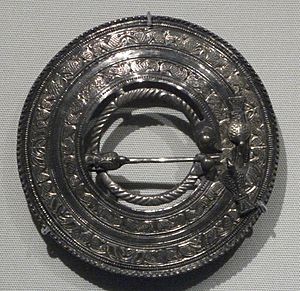
Quoit Brooches
The quoit brooch combines the annular (closed ring) and penannular (incomplete ring) forms. It has a double ring and is very detailed. The name comes from the rings used in the game of Quoits. The earliest ones were large, fancy silver brooches made in Kent in the mid-400s. Quoit brooches were probably worn alone.
Variations made of copper alloy in the 400s and 500s were likely worn in pairs on the shoulders. The Quoit Brooch Style is named after this elaborate brooch. It has a decorated flat ring around an incomplete ring. A pin goes through a slit in the inner ring and is held by knobs. The outer ring often has chip-carved geometric patterns, animals, sea creatures, and human faces.
The most important example is the Sarre brooch. It was found in an Anglo-Saxon cemetery near Kent. It has detailed three-dimensional birds on the ring and pin. It is now in the British Museum.
Miscellaneous Annular Brooches
Other annular brooch forms include the broad-framed brooch, the chunkier ribbed annular brooch, and late Anglo-Saxon annular brooches. The broad-framed was smaller with a wider frame than typical annular brooches. The chunkier annular is rare. It has a thicker oval frame and cast decoration. Experts can only date these brooches to a wide range from the late 400s to the early 700s.
Late Anglo-Saxon annular brooches, popular in the 500s and 600s, became smaller over time. Their decoration was often plain, simple, or in a style called Style II.
Penannular Brooches
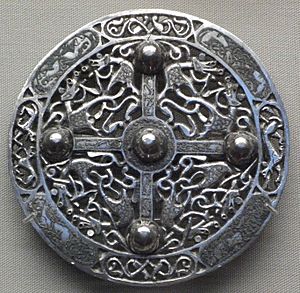
This brooch is an incomplete circle of wire or flattened metal with a pin across it. It is less common than the annular brooch. Like the annular, the penannular is usually decorated with parallel marks or a ring of stamps.
There are two main types found in early Anglo-Saxon graves. One has coiled ends, and the other has many-sided ends. Both were worn at the shoulders. The brooch was popular from the 500s to the 600s, and even into the 700s. It was found in similar areas to the annular brooch: southern England, the midlands, east anglia, and north east England. After the 600s, penannular brooches were made in Celtic, Irish, and Viking art styles.
Openwork Disc Brooches
The openwork disc brooch has a metal ring with an open, cut-out design. These delicate brooches were usually made of copper alloy. However, the most famous examples, the Pentney Hoard brooches, were cast in silver. They are commonly found in the Midlands and date from the early 500s. These delicate brooches were often worn in pairs on the shoulders.
The most important collection of openwork brooches was found by a gravedigger in a Pentney, Norfolk churchyard in 1978. This treasure of six brooches, called the Pentney Hoard, is now in the British Museum. Five of the six brooches are thought to be from the 800s, and one from the 900s. The largest brooch's size and raised decorations are similar to brooches from the later 800s and 900s. Another well-known openwork example is the silver and niello Strickland Brooch, also from the 800s.
Other Shaped Brooches
Brooches that were not circular or long were rare in early Anglo-Saxon England. Of these, bird-shaped or S-shaped brooches were the most popular. Bird-shaped brooches are usually found in the Kent area. Craftsmen from Kent created their own unique bird brooch style. The chunky European bird that faced right became a slender English bird brooch that faced left. Anglo-Saxon bird brooches date from 500 to 550 AD in England.
S-shaped brooches came from Continental Europe. They can be found across Anglo-Saxon England and date from 450 to 550 AD.
Middle to Late Anglo-Saxon Brooches
By the middle to late Anglo-Saxon era, circular brooches were the main style. These circular brooches were either enamelled (with colourful glass) or not. Ansate brooches, which were traditional European brooches, became popular in England later on. Safety-pin brooches were more common in the early Anglo-Saxon period. They became less fashionable by the 600s. The safety-pin brooch then changed into the strip brooch.
Safety Pin Brooches
Safety-pin brooches are quite rare in the 600s. Made of silver or copper alloy, these simple clothing fasteners look like modern safety-pins. A single piece of wire is coiled at the top to form the spring for the pin. From the 700s onwards, this brooch style changed into the strip brooch.
Strip Brooches
A strip brooch is made from a single piece of copper alloy. Strip brooches can be made in two ways. Either the brooch is one piece, with one end forming the spring and pin, and the other bent into a catchplate. Or, the plate has a separate riveted-on spring, pin, and catch plate. These styles can be grouped by the shape of the brooch front. One style looks like a modern safety-pin. Another has a flat and narrow front plate. A third style has a diamond-shaped plate.
Ansate Brooches
Ansate (bow) brooches are equal-armed brooches that came from Europe. They were popular in Northwestern Europe from the 400s to the 600s. The ansate brooch came to England in the 600s and was commonly used by the 900s.
This brooch has two equally sized ends with a curved (bow) section in the middle. They are small brooches, usually 3 to 5 centimetres wide. Most are made of copper alloy.
The ansate brooch is probably the least studied Anglo-Saxon brooch. It was once thought to be a rare European import. But with more metal detecting and the creation of the Portable Antiquities Scheme in 1997, many more have been found. Now, these brooches are seen as a common style in middle to late Anglo-Saxon England.
Circular Brooches
The circular brooch was the main type from the 600s to the 1000s. Circular brooches from this time can be divided into enamelled and non-enamelled types. Many amazing brooches were made from the 800s to the 1000s. Some of these fancy brooches include the Strickland Brooch, the Fuller Brooch, and the brooches from the Pentney Hoard.
Enamelled Brooches
Enamelling is a process where glass is melted onto a metal surface using very high heat. This technique allows craftsmen to create bright, colourful images. Anglo-Saxon enamelled brooches used two main enamelling techniques: champlevé and cloisonné.
Champlevé means 'raised field' in French. In this process, shallow sunken cells are cast into the metal. These cells are then filled with enamel. Cloisonné means 'partitioned'. This process involves creating cells by soldering vertical walls onto a disc backplate.
Anglo-Saxon craftsmen used various enamelling techniques, with champlevé being the most common. The three most popular enamelled brooch styles of this period were the enamelled cross, the saint motif, and the cloisonné brooch.
Non-enamelled Brooches
There are many different kinds of non-enamelled circular brooches. The most common styles include: the back-turned animal, coin, cross, concentric circle, stepped, and cogwheel shapes.
Miscellaneous Brooches
There were various other enamelled and non-enamelled brooch styles during this period. The most common were rectangular, bird-shaped, Ottonian, and cross-shaped styles. Most rectangular brooches found in England are not enamelled. They can be grouped into those with straight sides and those with curved sides.
Ottonian brooches were complex, three-dimensional brooches brought from Europe. Bird-shaped brooches from this time usually have a raised wing, a fan-shaped tail, and a crested head. They also show two legs with claws joined together.
Images for kids
-
Penrith Hoard brooches, Irish Viking style
See also
- Brooch
- Anglo Saxon art
- Migration period art
- Strickland Brooch
- Fuller Brooch
- Hunterston Brooch
- Celtic brooch
- Quoit brooch
- Ædwen's brooch


